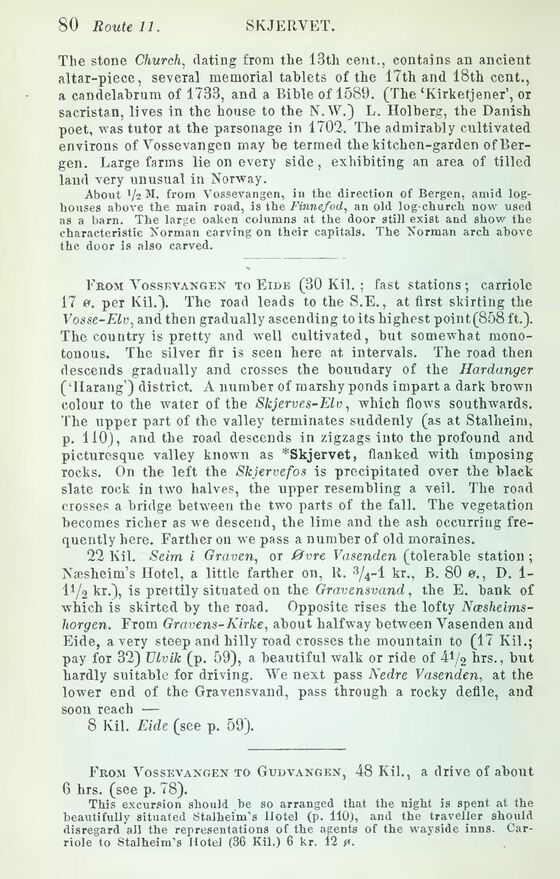
Full resolution (JPEG) - On this page / på denna sida - Norway - Pages ...

<< prev. page << föreg. sida << >> nästa sida >> next page >>
Below is the raw OCR text
from the above scanned image.
Do you see an error? Proofread the page now!
Här nedan syns maskintolkade texten från faksimilbilden ovan.
Ser du något fel? Korrekturläs sidan nu!
This page has never been proofread. / Denna sida har aldrig korrekturlästs.
The stone Church, dating from the 13th cent., contains an ancient
altar-piece, several memorial tablets of the 17th and 18th cent.,
a candelabrum of 1733, and a Bible of 1589. (The ‘Kirketjener’, or
sacristan, lives in the house to the N.W.) L. Holberg, the Danish
poet, was tutor at the parsonage in 1702. The admirably cultivated
environs of Vossevangen may be termed the kitchen-garden of
Bergen. Large farms lie on every side, exhibiting an area of tilled
land very unusual in Norway.
About V2 M. from Vossevangen, in the direction of Bergen, amid
log-houses above the main road, is the Finnefod, an old log-church now used
as a barn. The large oaken columns at the door still exist and show the
characteristic Norman carving on their capitals. The Norman arch above
the door is also carved.
Fbom Vossevangen to Eide (30 Kil. ; fast stations; carriole
17 0. per Kil.). The road leads to the S.E., at first skirting the
Vosse-Elv, and then gradually ascending to its highest point (858 ft.).
The country is pretty and well cultivated, but somewhat
monotonous. The silver fir is seen here at intervals. The road then
descends gradually and crosses the boundary of the Hardanger
(‘Harang’) district. A number of marshy ponds impart a dark brown
colour to the water of the Skjerves-Elv, which flows southwards.
The upper part of the valley terminates suddenly (as at Stalheim,
p. 110), and the road descends in zigzags into the profound and
picturesque valley known as *Skjervet, flanked with imposing
rocks. On the left the Skjervefos is precipitated over the black
slate rock in two halves, the upper resembling a veil. The road
crosses a bridge between the two parts of the fall. The vegetation
becomes richer as we descend, the lime and the ash occurring
frequently here. Farther on we pass a number of old moraines.
22 Kil. Seim i Graven, or Øvre Väsenden (tolerable station;
Næsheim’s Hotel, a little farther on, It. 3/4-l kr., B. 80 0., D.
1-■4 kr.), is prettily situated on the Gravensvand, the E. bank of
which is skirted by the road. Opposite rises the lofty
Ncesheims-horgen. From Gravens-Kirke, about halfway between Väsenden and
Eide, a very steep and hilly road crosses the mountain to (17 Kil.;
pay for 32) Vivik (p. 59), a beautiful walk or ride of 41/2 hrs., but
hardly suitable for driving. We next pass Nedre Väsenden, at the
lower end of the Gravensvand, pass through a rocky defile, and
soon reach —
8 Kil. Eide (see p. 59).
From Vossevangen to Gudvangen, 48 Kil., a drive of about
6 hrs. (see p. 78).
This excursion should be so arranged that the night is spent at the
beautifully situated Stalheim’s Hotel (p. 110), and the traveller should
disregard "all the representations of the agents of the wayside inns.
Carriole to Stalheim’s Hotel (36 Kil.) 6 kr. 12 n. .
<< prev. page << föreg. sida << >> nästa sida >> next page >>